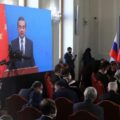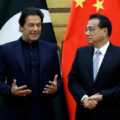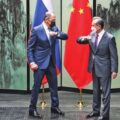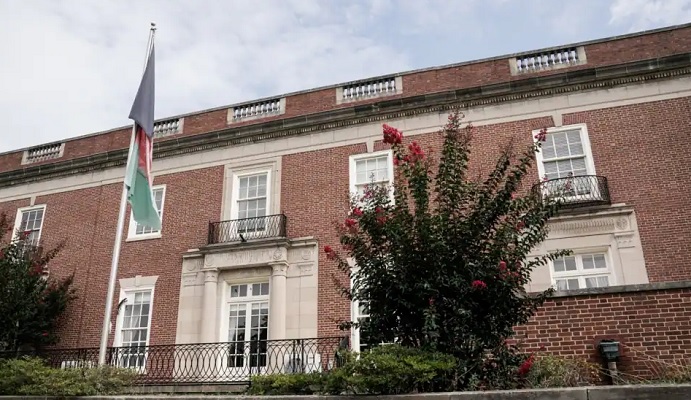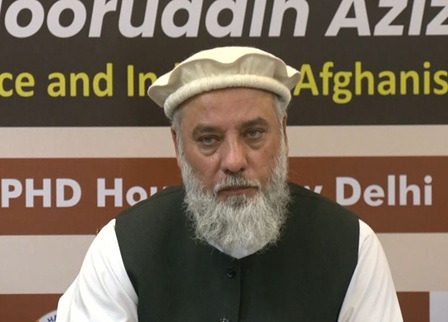
Courtesy: https://jamestown.org
Introduction
At a trilateral meeting in Islamabad on May 9, the foreign ministers of China, Pakistan and Afghanistan agreed to extend the China-Pakistan Economic Corridor (CPEC) into Afghanistan and reaffirmed their support for multilateral infrastructure projects already underway, including the Central Asia-South Asia (CASA) power project and the Trans-Afghan Railways (People’s Republic of China Ministry of Foreign Affairs [FMPRC], May 9). Earlier on January 5, the Taliban regime signed an agreement with the Xinjiang Central Asia Petroleum and Gas Company (CAPEIC), a subsidiary of the state-owned China National Petroleum Company (CNPC), for the extraction of oil from the Amu Darya basin, under which China will invest $150 million annually for three years and increase it thereafter to $540 million for the contract’s 25-year duration (Kabul Now, January 5). Then on April 13, Afghanistan’s Ministry of Mines and Petroleum announced that the Chinese company Gochin had expressed interest in investing $10 billion in Afghanistan’s lithium reserves (Kabul Now, April 13). Meanwhile, China is reported to be in talks with the Taliban regime over renegotiating the terms of a 2008 contract to mine copper from the Mes Aynak reserves in Logar province (The Print, June 8, 2022).
The agreements, including plans to extend CPEC—a key leg of China’s Belt and Road Initiative (BRI)—into Afghanistan, are a significant development. The deal relating to oil extraction in the Amu Darya basin is the Taliban regime’s first major foreign investment deal. However, in the past, major Chinese projects have failed to take off. Will the recent deals remain in limbo as well? China’s growing role in Afghanistan faces formidable challenges.
Limited Engagement
Although China shares a border with Afghanistan, it remained largely aloof from developments in the country for decades. Apart from covert support for the U.S. arming of the Mujahideen in the 1980s, the People’s Republic of China (PRC) kept its distance from its turbulent neighbor. Moreover, Beijing maintained no official diplomatic ties with the first Taliban regime (1996-2001) (Observer Research Foundation [ORF], August 6, 2019).
While Beijing revived diplomatic relations with Kabul following the ouster of the Taliban regime in 2001, its role in Afghanistan remained small, especially compared to that of the U.S. and other major powers. It had few interests to protect or advance in Afghanistan at that time. Besides, the PRC was not interested in playing a subordinate role to the U.S. and did not send troops to support the U.S.-led counter-insurgency operations in Afghanistan (Indian Council of World Affairs, April 20, 2022). Even its support for Afghan reconstruction was “modest,” with China providing just $240 million in financial aid between 2001 and 2013 (Institute for South Asian Studies (ISAS), June 25, 2021). In comparison, the U.S. extended $146.68 billion towards Afghan relief and reconstruction in the 2001-2020 period (Special Inspector General for Afghan Reconstruction).
China’s Interests in Afghanistan
Only after Afghan President Hamid Karzai announced the opening of Afghanistan’s energy, mineral and raw materials sectors to foreign investment did China begin to show an interest in Afghanistan (Eurasia Review, May 18, 2010). Afghanistan’s natural resource wealth is estimated at between $1 and $3 trillion (Global Times, September 14, 2021). In 2007, China Metallurgical Group Corporation (MCC) won a contract to mine copper from Mes Aynak, the world’s second-largest copper deposit. China’s pledge to invest $3 billion was the single largest foreign investment tender to date (China Daily, August 13, 2018). In 2011, China National Petroleum Corporation (CNPC) and its Afghan partner, Watan Oil & Gas, secured the rights to three oil blocks in the Amu Darya basin, with plans to invest $700 over five years (Tolo News, December 26, 2011). Other deals for infrastructure projects followed.
Afghan stability is required not only for the success of Chinese investments and economic interests but also because it has implications for the security situation in the western region of Xinjiang. Since the 1990s, Beijing has perceived a growing risk of Uyghur separatism in Xinjiang. Some Uyghur militants that the PRC has ascribed as belonging to the East Turkistan Islamic Movement (ETIM) have taken sanctuary in Afghanistan, purportedly allied to the Taliban and al-Qaida. International experts question the existence of ETIM as a coherent militant organization (see China Brief, February 11, 2022) and the U.S. government removed the group’s designation as a terrorist organization in October 2020 due to a lack of evidence for its continued existence (RFA, November 5, 2020). However, the PRC continues to see Uyghur militancy in Afghanistan as a major threat, viewing the security situation in its Central Asian neighbor through the prism of its longstanding struggle with the “three evil forces” (三股势力) of “ethnic separatism” (民族分裂势力), “religious extremism” (宗教极端势力) and “violent terrorism” (暴力恐怖势力) (Xinhuanet, June 13, 2019).
Since the early 2000s, a particular concern for Beijing has been that Uyghur militant groups and their allies could use the experience gained on the Afghan battlefield against Western and Afghan government forces to target China. Consequently, stability in Afghanistan has taken on growing importance to China over the past two decades. As Davood Moradian, director of the Afghan Institute for Strategic Studies, pointed out in 2015, it prompted Beijing to link “its internal security policy with the stability in Afghanistan” (Anadolou Agency, January 24, 2015).
Of course, strategic concerns also came into play with regards to Afghanistan. China was uneasy with the post-2001 surge in American presence and influence in Afghanistan. But this concern was secondary to its interest in Afghan stability. Hence, it did not raise objections to the U.S. counter-insurgency efforts, choosing to free-ride on its efforts to stabilize Afghanistan.
Rising Concerns, Growing Role
However, the role of a bystander was increasingly not an option for China. The situation in Xinjiang deteriorated, as evident from the outbreak of riots in Urumqi in July 2009 and the Uighur militants’ attack on a police station in Hotan in southern Xinjiang in 2011 (ORF, August 6, 2019). Meanwhile, Chinese economic interests in the region grew as the Belt and Road Initiative (BRI) got underway in 2013. Given its geographic location along the BRI, Afghanistan’s development and stability were important to the success of the effort. The Chinese government was eager to involve Afghanistan in the BRI, and the two countries signed a Memorandum of Understanding in this regard in 2016 under which Beijing pledged an investment of roughly $100 million in infrastructure projects (FMPRC, May 18, 2016). However, this investment did not materialize (The Hindu, July 5, 2022). Indeed, Beijing’s plans for mineral and oil extraction from the Mes Aynak mines and the Amu Darya reserves, respectively, did not make progress either. Persisting instability in Afghanistan contributed to Chinese projects not taking off.
Adding to Chinese concerns was U.S. President Barack Obama’s announcement in 2012 that American troops would begin to pull out from Afghanistan from 2014 onward. This brought home to the Chinese that, henceforth, they could not depend on the U.S. to stabilize Afghanistan. The pending U.S. withdrawal served as a catalyst for Beijing to shift its Afghan policy from one of “calculated indifference to strategic engagement” (ORF, August 6, 2019).
China’s Strategic Engagement in Afghanistan
In 2014, the PRC became more proactive in its efforts to promote stability in Afghanistan, with the Foreign Ministry appointing veteran diplomat Sun Yuxi as special envoy for Afghan affairs (China Daily, July 18, 2014). In October 2015, Beijing hosted the Heart of Asia Conference, where Chinese Foreign Minister Wang Yi called on “relevant countries…to help create conditions for the resumption of talks between the Afghan government and Taliban” (Global Times, December 10, 2015). Thereafter, China stepped up its mediation efforts, urging the Ashraf Ghani government and Taliban officials to talk directly to each other and leveraging close ties with Pakistan to enlist its support in the negotiation process (Express Tribune, March 13, 2015; ISAS, June 25, 2021). Parallelly, Beijing worked with the U.S., Russia and regional powers in bilateral and multilateral formats.
Importantly, China began providing military support to the Ghani government. In July 2015, it offered military equipment and training for Afghan soldiers for the first time (Dawn, July 11, 2015). The Taliban’s capture of Kunduz in September 2015 underscored to Beijing that the situation in Afghanistan was rapidly worsening and that it needed to intervene more robustly and quickly. In 2016, China supplied over $70 million in military aid to the Afghan government (Khaama Press, March 1, 2016). The PRC is reported to have helped Afghanistan build a military mountain brigade for deployment in the Wakhan Corridor bordering Xinjiang (South China Morning Post, August 28, 2018). It must be noted that even as China provided the Ghani government with military equipment, it kept up its outreach to the Taliban insurgents.
China and the Taliban Regime
Consequently, when the Taliban captured power on August 15, 2021, China was better placed than other powers to work with the new regime. Beijing quickly embraced the power shift, refrained from condemning the Taliban’s seizure of power, and kept its embassy open through the fall of Kabul (Xinhua, August 16, 2021). The PRC has maintained extensive diplomatic contact with the Taliban leadership and although it has not yet been extended official recognition, the Islamic Emirate is permitted diplomatic representation in Beijing (Global Times, June 23, 2022).
For the Taliban regime, which has failed to gain international recognition from any country yet and remains isolated under enormous economic pressure, aid, trade, and other support from Beijing are a veritable lifeline (China Brief, October 4, 2022). China has spoken out in Afghanistan’s favor at global forums, calling for the unfreezing of Afghan assets and the lifting of sanctions and other restrictions (Global Times, December 23, 2021; Global Times, June 17, 2022).
Unlike in 2002, China is keen to play a major role in Afghanistan today. With the U.S. gone, China is the dominant power in Afghanistan. Moreover, Beijing hopes to advance its substantial, yet largely unrealized, economic interests in the country. Within months of the Taliban’s return to power, contracts for projects that failed to take off under successive Republican governments, such as the Mes Aynak and Amu Darya projects, were reviewed and signed. Gaining access to Afghanistan’s lithium reserves is a priority for the Chinese economy. Chinese businesses have also expressed interest in investing in the agricultural and infrastructure sectors, including power projects as well as industrial parks (Global Times, April 28, 2022; Global Times, August 26, 2021). However, Afghan officials say that Chinese businessmen visit the country, make inquiries and do feasibility studies but do not return to invest (Japan Times, September 27, 2022). Instability and insecurity are stumbling blocks to moving forward with ambitious plans.
China in the ISKP’s Crosshairs
Although fighting has stopped, attacks by the Islamic State-Khorasan Province (ISKP) have surged in Afghanistan. Worryingly for the Chinese, they are in the ISKP’s crosshairs. ISKP propaganda has strongly criticized Chinese oppression of Uyghur Muslims and has accused China of “imperialism,” a reference to its BRI projects across the developing world (Terrorism Monitor, November 18, 2022). Importantly, ISKP’s targeting of China is not restricted to rhetoric but includes physical attacks. On December 12, 2022, the ISKP attacked a hotel in Kabul frequented by Chinese officials, businessmen, and students (Global Times, December 13, 2022). This was followed by a suicide attack on the Afghan foreign ministry building on January 11 of this year, when Taliban officials were inside engaged in a meeting with a Chinese official delegation (Al Jazeera, January 11).
Targeting China is an important part of the ISKP’s strategy to weaken the Taliban regime and undermine its efforts to revive the Afghan economy by wooing Chinese investments. These attacks are also aimed at appealing to hardline Taliban cadres, global jihadists and Uyghur Muslims by projecting the Islamic State as the true guardian of jihad, one that does not shy away from confronting China. The ISKP hopes to reap the benefits of this approach by drawing recruits from among Muslims who are angry with China’s oppression of Uighurs.
Is the Taliban a Reliable Partner for China?
Another major worry for Beijing is the possible threat posed by the ETIM and/or other Uyghur militants using Afghanistan as a base of operations. A related concern here is whether the Taliban regime will crack down on such groups. The Taliban’s record in this regard does not bode well. During its first regime as well as the insurgency, although it ensured that its Uyghur militant allies did not attack China, it provided them with shelter. In the months after it returned to power, the Taliban was under pressure from China to shut down camps purportedly operated by the Uyghur militant group in Badakhshan province in Afghanistan. However, the Taliban only shifted these camps away from the China border (RFERL, October 5, 2021). According to a 2022 United Nations report, the ETIM’s “operational space” has expanded in Afghanistan, with the group aligning with local Taliban commanders and buying weapons from them to boost its capability for “terrorist activities” (Japan Times, September 27, 2022).
Especially with ISKP propaganda targeting it for not standing up for Uyghur Muslims, the Taliban will likely refrain from cracking down on Uyghur militants. Moreover, the Taliban does not want disaffected Uyghur fighters allying with ISKP or Taliban members defecting to the ranks of ISKP. The presence of Uyghur militants in Afghanistan also provides the Taliban with leverage over China. Consequently, the regime is unlikely to “resolutely crack down” on them, as Beijing demands (Xinhua, September 10, 2021).
Chinese projects and nationals are also under threat from the Tehreek-e-Taliban Pakistan (TTP). In order to weaken the Pakistan government and its economy, the anti-Pakistan TTP has targeted Chinese consulates, CPEC and Chinese nationals in Pakistan (Dawn, November 14, 2018). Chinese projects in Afghanistan are potential targets as well (Global Times, September 18, 2021). However, the TTP may not want to antagonize the Taliban regime at this point for fear of losing its patronage and sanctuary on Afghan soil. Consequently, the TTP may prefer to limit its attacks to Chinese interests in Pakistan rather than targeting those in Afghanistan.
Will Beijing’s Plans Take Off?
China provides the Taliban regime with humanitarian aid, economic deals, and military equipment, including Blowfish attack drones (China Brief, January 19). Humanitarian assistance and economic projects could go some way in easing Afghan suffering. If implemented successfully, the recent deals are expected to create tens of thousands of jobs. However, doubts abound. While smaller Chinese businesses may survive, it will be difficult for major projects to take off given the dire security situation in Afghanistan.
China today is in the crosshairs of far more terror groups than the U.S. confronted in Afghanistan. Moreover, Beijing’s plans for Afghan stability involve consolidating Taliban rule. This is a shaky premise to begin with, as the Taliban is not a reliable ally. Roping in Pakistan to secure and stabilize Afghanistan is a non-starter, as Pakistan is itself roiled in unrest and instability and hardly in a position to put out fires next door.
Dr. Sudha Ramachandran is an independent researcher and journalist based in Bangalore, India. She has written extensively on South Asian peace and conflict, political and security issues for The Diplomat, Asian Affairs, and the Jamestown Foundation’s Terrorism Monitor and Militant Leadership Monitor. She can be contacted at [email protected].
